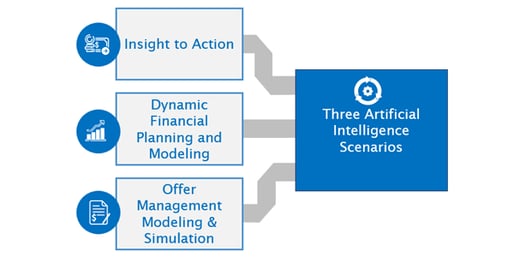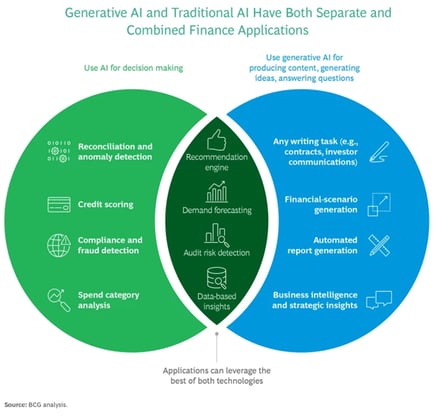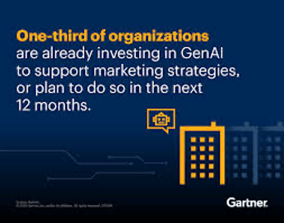Previously in this series, we have explored the big picture regarding How Generative AI is Impacting the Digital Solutions Economy. In this new post, we get more granular to provide an update on how AI and Gen AI can enhance productivity, insights, and results in finance applications such as order-to-cash to compliance (OTC2), along with a look at how new SAP AI initiatives are key to this transformation.
To help understand the various ways to combine traditional AI and Generative AI to accomplish operational, planning and strategic management goals, let's dive into three different scenarios.

Scenario One - Insights to Action
It's important to remember that traditional AI has actually been used in business for decades, in the form of machine learning, chatbots, predictive analytics, personalized marketing, etc. These types of applications still have relevance going forward and it is helpful to view them holistically within a broader overall AI ecosystem.
From a finance perspective, as illustrated below in this diagram from Boston Consulting Group, traditional functions such as reconciliation, credit scoring, fraud/risk detection, and spend categorization are not going away, but instead will benefit from Gen-AI capabilities to coalesce and interpret information to enable big picture insights and actions.
 Some of the specific use cases for order-to-cash to compliance include:
Some of the specific use cases for order-to-cash to compliance include:
- Product breakdown analysis that unifies the sales, finance, and revenue recognition aspects of the process.
- Interactive queries, such as identifying potential challenges with upcoming audits
- Proactive modeling and evaluations, such as impacts of pricing increases or discounts segregated by channels, geographies, etc.
To accomplish this cross-functional integration, the AI and Gen-AI applications need to have access to a comprehensive, shared infrastructure, such as the S/4HANA Cloud environment that uses a single Universal Journal repository, combined with seamless meshing of applications, such as SAP Contract Accounting (FI-CA), Order-to-Cash (OTC/BRIM), Revenue Accounting and Reporting (RAR), Treasury, Lease Accounting, and more.
Scenario Two - Dynamic Financial Planning and Modeling
With the above described infrastructure enabling broad enterprise-wide access to shared data, AI and Gen-AI can combine to provide advanced planning and modeling capabilities. Key improvements over current FP&A functionality will include:
- The ability to leverage real time information, such as dynamically changing market conditions, customer behaviors, supply chain disruptions, currency fluctuations, etc. to drive financial models.
- Options for quickly simulating multiple models for comparative analysis and decision-making.
- Proactive and automated decision support systems to identify and surface trends and risks that otherwise might not be considered.
- Using natural language processing (NLP) to make financial statement and public facing data more consumable to all types of stakeholders.
As with Scenario One, unified and consistent data will be key. Also, security of data being used in AI and Gen-AI planning will need to be rigorously managed to assure accuracy, timeliness, and security.
Scenario Three - Offer Management Modeling and Simulation
As noted in many of our posts on the Digital Solutions Economy, the watchword has become "disrupt or be disrupted". The rise of a myriad of subscription-based offerings with complex bundling, usage/consumption based models, and hybrid product/service approaches give companies attractive new recurring revenue opportunities but at the same time requires a high degree of agility, visibility and flexible adaptiveness.
 In this dynamic new world, the combination of AI and Gen-AI can give companies an important edge by enabling them to model and comprehensively analyze all the market, financial, and business aspects of various offer management plans.
In this dynamic new world, the combination of AI and Gen-AI can give companies an important edge by enabling them to model and comprehensively analyze all the market, financial, and business aspects of various offer management plans.
By melding anticipated customer profiles, pricing scenarios, costs, margins, risk factors and profitability projections, decision makers can gain valuable insights for refining and tuning all variables before greenlighting new product and service offerings.
For example, by using a combination of SAP Signavio, LeanIX, and other tools in the SAP S/4HANA ecosystem, companies can map out a detailed go to market plan, along with built-in checkpoints, metrics, and contingencies.
Summary
As illustrated by these three scenarios for the Digital Solutions Economy, Gen-AI has come of age and is poised to combine with traditional AI applications to usher in a wave of exciting new capabilities that can deliver tangible and actionable insights, along with the reality based underlying processes to drive productivity, innovation and business excellence to the next level.
The keys to success will be to take a holistic, strategic approach that is coupled with a comprehensive, unified, underlying data and systems infrastructure that can support the massive computational Gen-AI analysis, decision support, and content creation functions. SAP has clearly staked out a leadership position based on decades of integrating traditional AI, which is now encompassing Gen-AI with new initiatives destined to Shape the Future of Business Transformation in the Era of AI.

